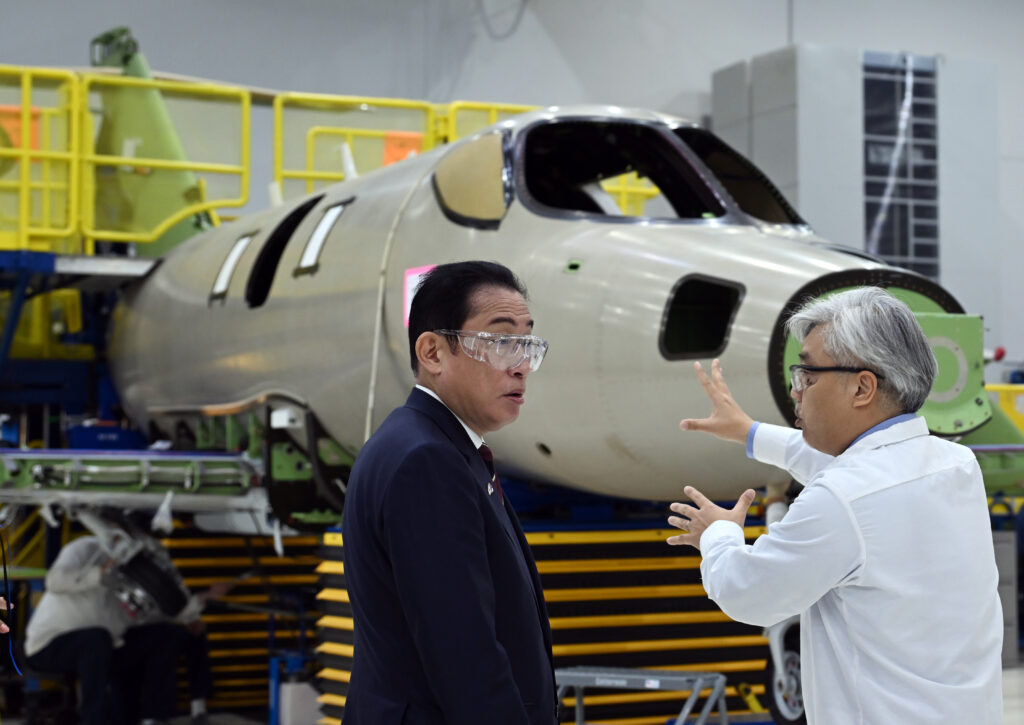Japanese Prime Minister Fumio Kishida’s decision to codevelop the Mitsubishi F-X fighter jet project marks another milestone in Japan’s incremental shift away from post-war pacifism, a process accelerated by former prime minister Shinzo Abe. Kishida’s move signals a new phase in the country’s approach to using arms transfers to recalibrate its role in international security.
Over the last decade, Japan has embraced arms transfers as a foreign policy tool to position itself as a proactive contributor to peace. In April 2014, then-prime-minister Abe and his ruling Liberal Democratic Party (LDP) lifted the long-standing ban on arms exports to allow arms transfers so long as they benefit international peace or Japan’s security. The new ‘Three Principles’ reversed the old policy that banned transfers to communist countries, countries sanctioned by the UN Security Council and countries engaged in military conflict.
One decade later in March 2024, Kishida’s Cabinet approved the export of a next-generation fighter jet co-developed with Italy and the United Kingdom to countries that have agreed to transfer military equipment from Japan. Japan decided to develop a new fighter jet to replace its ageing fleet as early as 2020.
With the development of Mitsubishi’s X-2 in the 2010s, Tokyo has signalled to move away from acquisition of US-made aircraft for its Japan Air Self-Defense Force (JASDF). The JASDF’S F-4, F-15, and F-35 aircraft were all made in the United States, while the F-2 was co-developed by the two allies. The F-1, developed in the 1970s, is Japan’s only homemade jet.
Past attempts to lift Japan’s ban on arms exports were aimed at recalibrating Japan’s role within the US–Japan alliance in the 1980s and post-Cold War era, as part of an intensive effort to ‘normalise’ Japan’s national security posture. Though the country has produced arms domestically since the 1950s, Japan accounted for just a tiny fraction of global exports before the 2010s at around 0.1%. This began to change with Abe’s attempts to build regional security cooperation with Australia and others in the face of China’s growing military presence.
Though Abe’s efforts were crucial in setting a new course for Japan’s arms transfer policy, they were mainly focused on strengthening the country’s regional role. Kishida and his cabinet are embracing arms transfers to strengthen Japan’s security cooperation within and beyond the Indo-Pacific.
The F-X project encapsulates the Kishida administration’s policy direction. Japan agreed in December 2022 to collaborate with Italy and the United Kingdom on a trilateral program to develop a next-generation fighter jet, resulting in the UK-based Global Combat Air Programme (GCAP). Defence companies from each country, such as BAE Systems, Leonardo and Mitsubishi Heavy Industries, hope to begin development of the sixth-generation F-X jet in 2025 and have it delivered by 2035. The jet will possess supersonic stealth capabilities and a new radar system.
GCAP was launched at the same time that Kishida proposed a significant increase in Japanese defence spending to 43 trillion yen (US$276 billion) by 2027, which would amount to 2 per cent of GDP in line with NATO spending guidelines. This push is part of Kishida’s new National Security Strategy, which outlines Japan’s global role in defence and security post-Ukraine.
The strategy includes strengthening ties with NATO and linking the Atlantic security community with the Indo-Pacific region. In December 2023, Japan approved the export of domestically produced Patriot interceptor missile systems. This move will allow Japan to transfer entire weapons systems to the United States, replenishing arsenals depleted by military aid sent to Ukraine and Israel.
In late 2023, Tokyo agreed to provide a 600 million yen (US$3.85 million) grant for a new coastal surveillance radar system in the Philippines to bolster defence capabilities and deterrence of China. Japan and Vietnam have also begun to fortify their ‘comprehensive strategic partnership’.
The GCAP is crucial in helping Japan extend its arms transfers efforts beyond Asia into an evolving multi-layered security architecture. It will aid Japan’s efforts to integrate and complement the Quad and AUKUS, the latter of which was initiated primarily to facilitate the export of nuclear submarines to Australia.
Critical to Kishida’s national security agenda, the legalisation of F-X exports faced opposition within the cabinet. The LDP’s coalition partner Komeito has been reluctant to further dismantle post-war pacifism. The junior coalition partner eventually agreed when Kishida promised strict export approval measures for the F-X jets, including cabinet oversight and a ban on arms and technology transfers to states involved in military conflict.
Japan’s past efforts to develop a new fighter jet were ultimately hampered by decisions to use the US-made F-4, F-15 and F-35 jets. In 2017, Abe agreed with the United States to buy 105 more F-35s on top of the 42 already ordered, giving Japan the largest F-35 fleet among US allies. This was not only a strategic decision to ‘make the alliance even stronger’, but also a political one to blunt then-president Donald Trump’s criticism of Japan’s perceived inadequate contribution to the alliance.
While Kishida’s decision to pursue trilateral F-X jet development takes Japan beyond the parameters of its alliance with the United States, it remains unclear whether Japan can maintain this course should Trump return to the White House in 2025.
Sebastian Maslow is Research Fellow at the Institute of Social Science, University of Tokyo.

